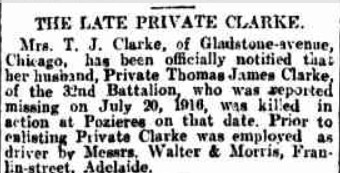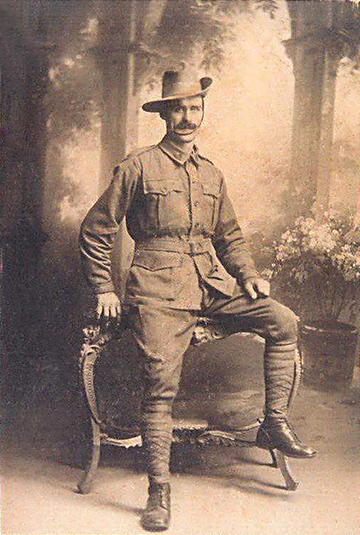
Thomas James CLARKE
Eyes blue, Hair dark, Complexion medium
Thomas James Clarke – A Family man lost
Can you help us identify Thomas James Clarke?
Tom was Killed in Action at Fromelles. As part of the 32nd Battalion he was positioned near where the Germans collected soldiers who were later buried at Pheasant Wood. There is a chance he might be identified, but we need help. We are still searching for suitable family DNA donors.
In 2008 a mass grave was found at Fromelles, a grave the Germans dug for 250 (Australian) bodies they recovered after the battle.
If you know anything of contacts or his relatives from South Australia, please contact the Fromelles Association.
See the DNA box at the end of the story for what we do know about his family.
Early Life
James Thomas Clarke, known as Tom, was born in 1882 in Brighton, Sussex, England. He was the youngest child of James Thomas Clarke (1844–1885), a plumber, and Mary Ann Eliza Clarke (née Aspenwall, 1850–1931), who was born in Blackfriars, Middlesex. James and Mary had married in Brighton in 1869.
The family emigrated to South Australia while Tom was still an infant, arriving aboard the Ashmore. On the passenger list, James was recorded as a plumber, travelling with his wife Mary and children Edith, Eliza, and James (Tom). They settled in Bowden, a working-class suburb of Adelaide.
Tragedy struck when James died in 1885, leaving Mary widowed with young children, including three-year-old Tom. In 1887, Mary remarried — this time to Thomas Gillies — and the family continued to grow in a blended household
Tom was raised alongside his siblings:
- William Thomas Clarke (1870–1871) – died in infancy
- Edith Mary Jane Clarke (1872–1955)
- Elizabeth "Eliza" Louisa Clarke (1874–1957), who married Charles S. Mincham and had ten children
- James (Tom) Thomas Clarke (1882–1916), killed at Fromelles
- William Ernest Gillies (1888–1943) [half-brother]
- George Clarke Gillies (1890–1953) [half-brother]
Life Before the War
Before the war, Tom was living in North Adelaide and working as a driver. In 1905, he married Blanche Ethel Haines, and together they built a life grounded in family and hard work. They had four children:
- Myrtle Gladys Clarke (1906–1908), who died in infancy
- Colin Thomas George Clarke (1908–1970), later married Sylvia Aufderheider
- Leonard James Clarke (1913–1990)
- Bernice Rose Clarke (5 February 1916–1998)
Off to War
Tom enlisted in the AIF on 10 April 1915 in Adelaide as Thomas James Clarke, and was assigned to the 32nd Battalion, 3rd Reinforcement and went to Mitcham Camp. After a month at Mitcham, the 32nd Battalion moved to Cheltenham Racecourse in mid-September to continue their training. The 32nd is a composite battalion - some 500 recruits from South Australia were formed into the A and B companies and from across the other side of the country at Blackboy Hill near Perth, Western Australia, another similar sized bunch of keen young men are training to form the other half of the battalion, making up the C and D companies.
The WA men joined the battalion in South Australia a few months later. At its peak, Mitcham Camp contained 4426 men and was the second largest town in South Australia. They lived in 10-man bell tents together and learned basic soldier skills such as physical training, bayonet fighting, rifle handling, bomb throwing and trench digging.
A couple of weeks later they were joined by the Western Australian lads - now a complete battalion, training for war.
Tom embarked from Adelaide on 7 February 1916 aboard HMAT Miltiades and disembarked in Suez on 11 March 1916. On 1 April, he was officially taken on strength with the 32nd Battalion while training at Duntroon Plateau, Egypt. He departed Alexandria on 17 June 1916, bound for France with the British Expeditionary Force, arriving at Marseilles on 23 June. He was assigned to B Company of the 32nd Battalion, which was quickly moved to the front lines for the upcoming operation at Fromelles.
As reported in The Adelaide Register “The 32nd Battalion went away with the determination to uphold the newborn prestige of Australian troops, and they were accorded a farewell which reflected the assurance of South Australians that that resolve would be realized.”
Source: THE 32ND BATTALION. (1915, December 16). The Register p. 6. http://nla.gov.au/nla.news-article59988928
Many of the men would never have left their own state or town, so the journey at sea is the real beginning of the adventure. Their route carries them along the Great Australian Bight, then turning northeast around the tip of Western Australia. Seasickness is interspersed with army drills, sightings of albatross, flying fish and whales before reaching the hot, humid and calmer waters of the equator. Boxing matches are held in the evenings, and the men often sleep on the deck. After a month at sea the 32nd battalion lands at Suez.
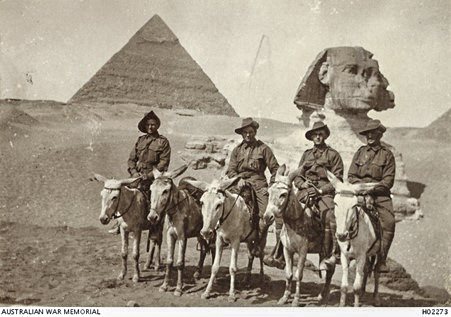
After landing, they spent four weeks at the El Ferdan outpost, several miles into the desert. Toms platoon was assigned to Ridge Post, a smaller post a few miles south of El Ferdan and closer to the Suez Canal where they can bathe and fish while off duty. The battalion spent the next six months rotating through various outposts and at the major training camp at Tel-El-Kebir. The men are given leave on occasion and many take the opportunity to visit Cairo and the pyramids. The 32nd Battalion’s stay in Egypt is relatively quiet; the Turkish do not mount any major attacks through the desert on the canal and their chief enemy is the stifling Egyptian sun and sand. George Bonney wrote at the time:
“We are in a deadly place now. Terribly hot and no water, only enough to keep you from thirst. If the Torrens River was here it would be worth its weight in gold. We get no face or clothes washed here….It’s a horrible place. All our water is carried by camels. You would be only too pleased to drink out of a horse trough, if you had the opportunity. Dirty water don’t stop us now. It’s worth more than tucker.”
The Battle of Fromelles
Only weeks after arriving in France, the 32nd Battalion were rushed into battle at Fromelles on 19–20 July 1916 — their first action on the Western Front. The 32nd moved to the Front on 14 July and were into the trenches for the first time on 16 July, in preparation for an assault on the German trenches at Fromelles. D Company’s Lieutenant Sam Mills’ letters home were optimistic for the coming battle:
“We are not doing much work now, just enough to keep us fit—mostly route marching and helmet drill. We have our gas helmets and steel helmets, so we are prepared for anything. They are both very good, so a man is pretty safe.”
On the 17th they were reconnoitring the trenches and cutting passages through the wires, preparing for an attack, but it was delayed due to the weather. The Australian 8th Brigade, which included the 32nd Battalion, were to cross about 100 metres of No-Man’s-Land and assault the German trenches on the left flank of the Allied attack. Being on the extreme left flank made their job even more difficult, as, not only did they have to protect themselves from the front, but they also had to block off the Germans on their left while advancing in order to prevent the Germans from coming around behind them.
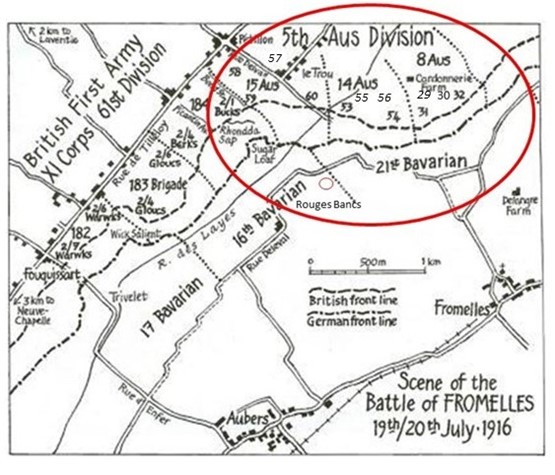
All were in position by 5.45 PM and the charge over the parapet began at 5.53 PM. C Company and A Company were the first and second waves to go, B & D the third and fourth. The first waves did not immediately charge the German lines, they went out into No-Man’s-Land and laid down, waiting for the British bombardment to lift. At 6.00 PM, the German lines were rushed. The Australians immediately suffered heavy casualties from the artillery and German rifle and machine gun fire. The 32nd were successful in their initial assaults and by 6.30 PM were in control of the German’s 1st line system.
Fighting continued through the night. The Australians made a charge at the main German line, but they were low on grenades, there was machine gun fire from behind and from the machine gun emplacement at Delangre Farm and they were so far advanced that they were getting shelled by both sides.
At 4.00 AM the Germans began an attack from the Australian’s left flank. Given the Australian advances that had been made earlier, their rear trench had been left almost empty, which then enabled the Germans to be in a position to surround the soldiers of the 32nd. At 5.30 AM the Germans attacked from both flanks in force and with bombing parties:
“The enemy swarmed in and the retirement across No Mans’ Land resembled shambles, the enemy artillery and machine guns doing deadly damage.”
The 32nd Battalion suffered appalling losses: 718 casualties out of 800 men, including 90% of its front-line strength. Tom was initially reported missing in action. A Court of Enquiry later confirmed he had been killed on 20 July 1916.
After the Battle
Tom’s body was never recovered and he has no known grave.
He is commemorated at:
- V.C. Corner Cemetery Memorial, Fromelles (No. MR 7)
- Australian War Memorial Roll of Honour (Panel 120)
- Adelaide National War Memorial
- Prospect Roll of Honour A–G WWI Board
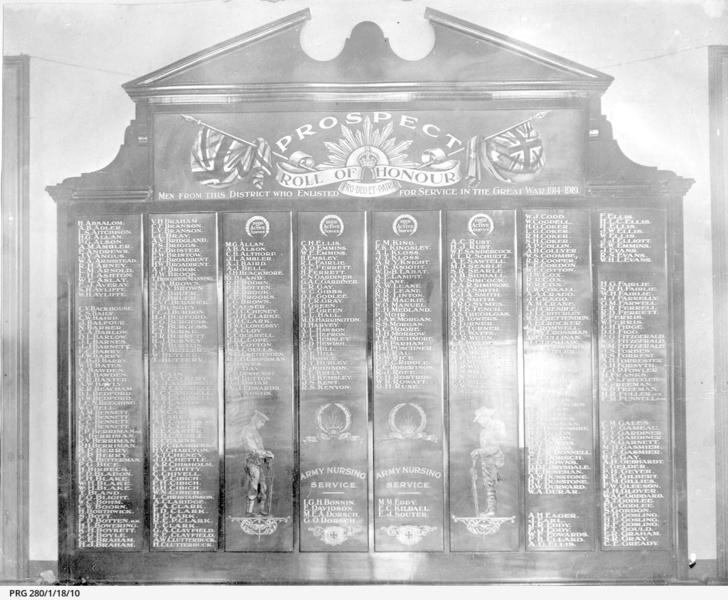
Tom’s death left a profound void in the life of his wife Blanche and their three surviving children. At just 34 years of age, Blanche faced widowhood, uncertainty, and the burden of raising Colin, Leonard, and Bernice on her own. The youngest, Bernice, born 5 Feb 1916, was only two days old when Tom embarked for war.
For years after his disappearance, Blanche tirelessly sought answers. In September 1917, she wrote to the Red Cross:
“The anxiety & suspense is just awful. I cannot eat or sleep. I have three young children — the youngest was only two days old when my husband left for the Front — & if I could only get some news of him, I would be indeed grateful.”
— Blanche E. Clarke, Medindie, South Australia
She also wrote to Sister Laird, head of the Red Cross Bureau:
“As my husband has been reported missing since July 20th, 1916, I am writing in the hope that you may know something of him... Any news but all would be very acceptable, as the suspense of anxiety and doubt is awful.”
Even in official correspondence to military authorities, Blanche expressed anguish:
“I regret very much to say that I have no information whatever regarding my late husband. I received notice that he was missing on the 20th of July 1916 and twelve months later that he was killed in action on that date. I was not even notified where he was missing from.”
Over a year later on 21st September 1917, she was still searching for answers:
Friday, Sept. 21st, ’17
To the Officer in Charge, Base Records, Melbourne
Dear Sir,
I am just sending these few lines to ask if you can give me any more particulars regarding my husband, No. 1995, Pte. James Thomas Clarke, A. Company, 52nd Batt. 8th Brigade, 2nd Division, A.I.F., who was reported as missing on the 20th July, 1916, and reported as killed in action in that year.
I have this morning received a letter from a mate of his in Aug. (1916) written just after he was reported missing, in it he said he had just buried him on the field where he had been seriously wounded, also another said he had been wounded by a bomb, and only kept singing to his mates not to forget him, as he was dying.
From what I can gather, and from reports in other cases, there is a great possibility that he was not killed, but seriously injured and as he was slightly out of his mind (as his mates said), he may have wandered into the German lines (as they evidently did).
This gave me the thought that he may be a prisoner somewhere, or affected mentally.
Would I be notified if he was in a mental hospital either in Australia or abroad.
Sincerely hoping you will be able to give me some more information.
Believe me, Yours respectfully, Blanche E. Clarke
Finally in 1921, in answer to another plea, she received the following response.

The years passed, but her grief never diminished. In 1928, on the twelfth anniversary of Tom’s death, she placed a tribute in The Advertiser:
“What would I give his hand to clasp,
His dear kind face to see;
To have his voice, to see his smile,
That meant so much to me.”
— Fondly remembered by his loving wife and daughter, Bernice
Multiple memorial notices from family members spoke to the deep pain of his loss. Tom Clarke was never recovered, but he was never forgotten.
We can presume that Tom’s extended family (his mother died 1931) and Blanche’s family - who were all Adelaide based were a strong support for Blanche. Her mother and unmarried sister Minnie were living in Prospect, where Blanche was living in 1921.
Can you help us identify Tom?
DNA is still being sought to help identify Tom and return his name to one of the unknown graves at Fromelles. If you are related to the Clarke or Aspenwall families from South Australia or England, please contact the Fromelles Association of Australia.
DNA samples are being sought for family connections to
| Soldier | James Thomas (Tom) Clarke (1882–1916) |
| Parents | James Thomas Clarke (1844–1885) and Mary Ann Eliza Aspenwall (1850–1931) |
| Siblings | William Thomas Clarke (1870–1871) [died in infancy] | ||
| Edith Mary Jane Clarke (1872–1955) | |||
| Elizabeth Louisa Clarke (1874–1957) | |||
| William Ernest Gillies (1888–1943) [half-brother] | |||
| George Clarke Gillies (1890–1953) [half-brother] |
| Grandparents | ||||
| Paternal | Henry Clarke (1817–1848) and Jane Stevens (1821–) Brighton, Sussex. | |||
| Maternal | Isaac Fulham Aspenwall (1822–1880) and Mary Ann Davis Lockwood (1826–1909) | London |
Seeking DNA Donors

Contacts
(Contact: carla@fromelles.info or geoffrey@fromelles.info).
(Contact: army.uwc@defence.gov.au or phone 1800 019 090).
Donations
If you are able, please contribute to the upkeep of this resource.
(Contact: bill@fromelles.info ).
